

Mid-Term Break Summary & Analysis by Seamus Heaney
- Line-by-Line Explanation & Analysis
- Poetic Devices
- Vocabulary & References
- Form, Meter, & Rhyme Scheme
- Line-by-Line Explanations
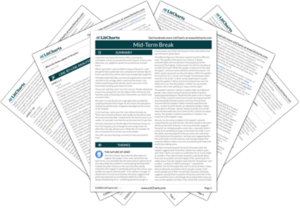
“Mid-Term Break” was published by Irish poet Seamus Heaney in his 1966 book Death of a Naturalist. The poem is about Heaney’s brother, who was killed by a car in 1953 when he was only 4 years old, and Heaney only 14. Personal and direct, the poem describes the unexpected ways his family’s grieves as they confront this tragedy. It also notes the way that grief may upset traditional social roles.
- Read the full text of “Mid-Term Break”

The Full Text of “Mid-Term Break”
“mid-term break” summary, “mid-term break” themes.

The Nature of Grief
Line-by-line explanation & analysis of “mid-term break”.
I sat all ... ... drove me home.

In the porch ... ... a hard blow.
The baby cooed ... ... for my trouble'.
Lines 11-13
Whispers informed strangers ... ... angry tearless sighs.
Lines 14-15
At ten o'clock ... ... by the nurses.
Lines 16-18
Next morning I ... ... in six weeks.
Lines 18-22
Paler now, ... ... for every year.
“Mid-Term Break” Symbols

- Line 2: “bells”

- Line 16: “Snowdrops”

- Line 17: “candles”
“Mid-Term Break” Poetic Devices & Figurative Language
End-stopped line.
- Line 2: “close.”
- Line 3: “home.”
- Line 4: “crying—”
- Line 5: “stride—”
- Line 6: “blow.”
- Line 10: “trouble'.”
- Line 11: “eldest,”
- Line 13: “sighs.”
- Line 15: “nurses.”
- Line 18: “now,”
- Line 19: “temple,”
- Line 20: “cot.”
- Line 21: “clear.”
- Line 22: “year.”
- Lines 1-2: “bay / Counting”
- Lines 7-8: “pram / When”
- Lines 8-9: “embarrassed / By”
- Lines 9-10: “hand / And”
- Lines 12-13: “hand / In”
- Lines 14-15: “arrived / With”
- Lines 16-17: “Snowdrops / And”
- Lines 17-18: “him / For”
- Line 8: “in, and”
- Line 12: “school, as”
- Line 15: “corpse, stanched”
- Line 16: “room. Snowdrops”
- Line 17: “bedside; I”
- Line 18: “weeks. Paler”
- Line 21: “scars, the”
- Line 22: “box, a”
Alliteration
- Line 1: “c,” “b”
- Line 2: “C,” “b,” “c,” “l,” “c,” “l”
- Line 3: “cl”
- Line 4: “m,” “m”
- Line 5: “H,” “h”
- Line 12: “A,” “a,” “a,” “m,” “m,” “h,” “m,” “h”
- Line 13: “h,” “a”
- Line 14: “A,” “a,” “a”
- Line 15: “b,” “b”
- Line 16: “S”
- Line 17: “s,” “s”
- Line 18: “F,” “f,” “s,” “P”
- Line 19: “p,” “b,” “h,” “l”
- Line 20: “H,” “l,” “f,” “f”
- Line 22: “f,” “f,” “f,” “f”
- Line 2: “e,” “e,” “o”
- Line 3: “o,” “o,” “o”
- Line 4: “I,” “y,” “y”
- Line 5: “a,” “a,” “i,” “i”
- Line 6: “i,” “i,” “i,” “i,” “a,” “a”
- Line 7: “a,” “au,” “a,” “a”
- Line 8: “I,” “a,” “I,” “a”
- Line 9: “a,” “a”
- Line 11: “i,” “i”
- Line 12: “a,” “a,” “a”
- Line 13: “a,” “a,” “i”
- Line 14: “A,” “a,” “i”
- Line 15: “a,” “a,” “a”
- Line 16: “o,” “oo”
- Line 17: “A,” “a,” “oo,” “i,” “I”
- Line 18: “i,” “i”
- Line 19: “o,” “o,” “e,” “e”
- Line 20: “o,” “i,” “i,” “o”
- Line 21: “au,” “o”
- Line 22: “ou,” “oo,” “oo,” “o,” “y,” “ea”
- Line 1: “s,” “ll,” “n,” “n,” “c,” “ll,” “s,” “ck,” “b”
- Line 2: “C,” “n,” “b,” “ll,” “s,” “kn,” “ll,” “cl,” “ss,” “s,” “cl,” “s”
- Line 3: “t,” “t,” “cl,” “r,” “r,” “r,” “m,” “m”
- Line 4: “m,” “m,” “th,” “r,” “r”
- Line 5: “H,” “h,” “n,” “n,” “r,” “n,” “h,” “s,” “r,” “d”
- Line 6: “d,” “b,” “w”
- Line 7: “b,” “b,” “c,” “d,” “nd,” “d,” “nd,” “r,” “ck,” “d,” “r,” “m”
- Line 8: “c,” “m,” “n,” “n,” “m”
- Line 9: “d,” “m,” “n,” “nd,” “m,” “nd”
- Line 10: “t,” “rr,” “t,” “r”
- Line 11: “rs,” “r,” “s,” “t,” “r,” “rs,” “s,” “s,” “t”
- Line 12: “m,” “m,” “h,” “d,” “m,” “h,” “d”
- Line 13: “h,” “r,” “s,” “t,” “r,” “t,” “r,” “ss,” “s,” “s”
- Line 14: “t,” “t,” “rr”
- Line 15: “r,” “s,” “s,” “n,” “d,” “nd,” “b,” “nd,” “d,” “b”
- Line 16: “S,” “d,” “s”
- Line 17: “nd,” “nd,” “s,” “s,” “d,” “e,” “s,” “d,” “s”
- Line 18: “F,” “r,” “f,” “r,” “st,” “t,” “s,” “x,” “s,” “P”
- Line 19: “p,” “pp,” “l,” “t,” “p,” “l”
- Line 20: “l,” “f,” “r,” “f,” “b,” “x,” “c”
- Line 21: “c,” “r,” “m,” “r,” “ck,” “m,” “c”
- Line 22: “f,” “r,” “f,” “t,” “f,” “t,” “f,” “r,” “r,” “y,” “y,” “r”
- Line 20: “He lay in the four-foot box as in his cot.”
- Line 19: “Wearing a poppy bruise”
Polysyndeton
- Line 7: “The baby cooed and laughed and rocked the pram”
- Line 20: “four-foot box”
- Line 22: “A four-foot box, a foot for every year.”
“Mid-Term Break” Vocabulary
Select any word below to get its definition in the context of the poem. The words are listed in the order in which they appear in the poem.
- In His Stride
- Four-foot box
- (Location in poem: Line 1: “college”)

Form, Meter, & Rhyme Scheme of “Mid-Term Break”
Rhyme scheme, “mid-term break” speaker, “mid-term break” setting, literary and historical context of “mid-term break”, more “mid-term break” resources, external resources.
Seamus Heaney's 10 Best Poems — A list of Heaney's 10 Best Poems from the Telegraph—offering a good introduction to his broader work.
Heaney Restrospective — A critical appraisal of the poet's life and work, from Naomi Schalit.
Seamus Heaney's Life — A detailed biography from the Poetry Foundation.
Seamus Heaney Reads "Mid-Term Break" — The poet reads his own poem aloud for the Poetry Ireland Lunchtime Reading Series.
Heaney's Family on Life with the Poet — In an article for the Guardian Newspaper, Seamus Heaney's family reflect on life with Heaney.
LitCharts on Other Poems by Seamus Heaney
Blackberry-Picking
Death of a Naturalist
Out of the Bag
Personal Helicon
Requiem for the Croppies
Storm on the Island
The Tollund Man
Everything you need for every book you read.

Poetry Prof
Read, Teach, Study Poetry
Mid-Term Break
Seamus Heaney shares with us a sad memory from his childhood.
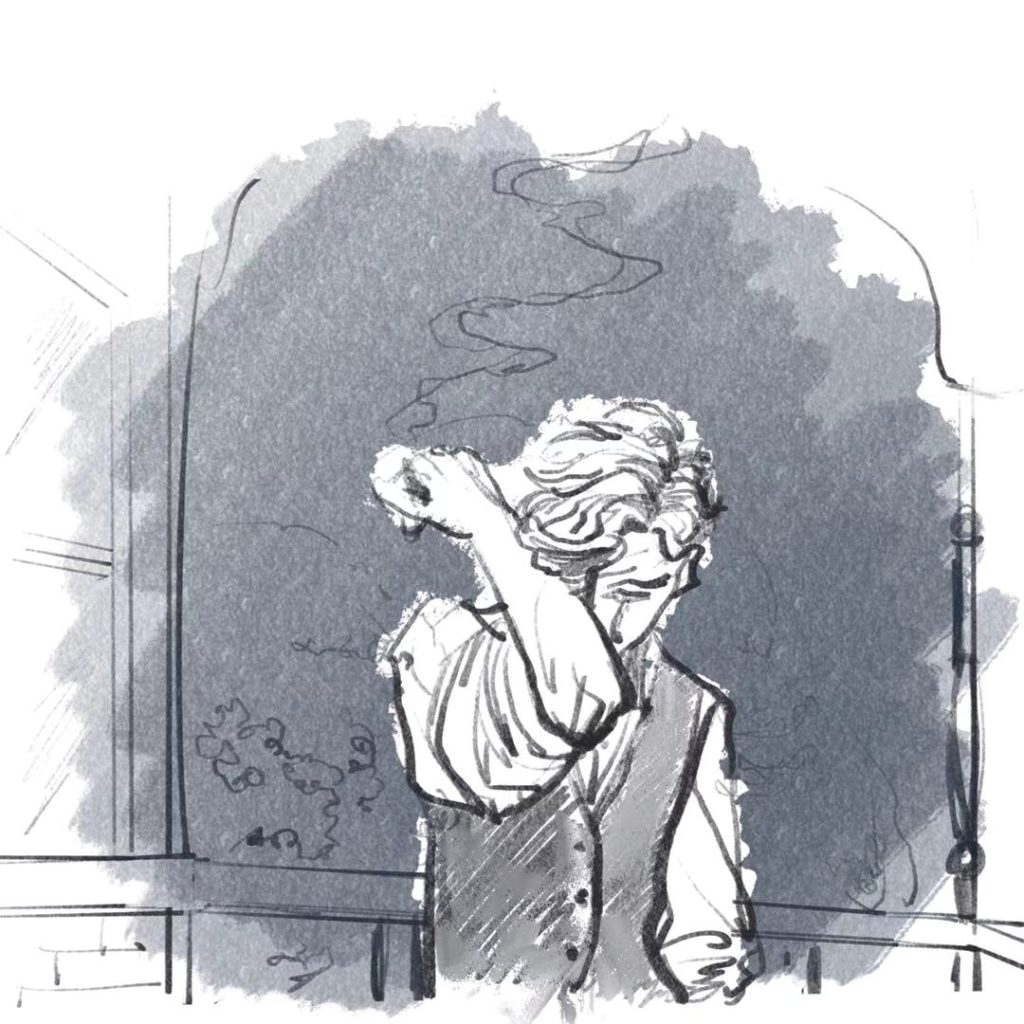
“… the most skilful and profound poet writing in English today.” Edward Mendelson (NYT Review of Opened Ground)
Seamus Heaney is one of the most recognisable names in English-language poetry . It’s quite possible that you could hear his writerly voice as a child, study him as you get older (his poems are often anthologised or selected for GCSE and A Level study) and come to regard him as an old familiar friend through your adult life. Heaney won the Nobel Prize for Literature in 1995 and turned down the position of Poet Laureate when it was offered to him, possibly because he regards himself as Irish, not British : after lunching with the Queen he said, “I have nothing against the Queen personally”; but in 1982 he published the lines, “My passport’s green/ No glass of ours was ever raised/ To toast the Queen.” Before his death in 2013 he wrote about Irish community life, people’s connection with the land ( Storm on the Island; Bogland ), politics and history (particularly The Troubles), his own rural upbringing and journey to becoming a writer ( Follower; Digging; Personal Helicon ). A recognisable Heaney trait is filtering subject matter through a child’s looking-glass lens. His most famous poems ( Death of a Naturalist and Blackberry Picking) are directly concerned with childhood, in particular the loss of childhood innocence as one grows older. Mid-Term Break (from the collection Death of a Naturalist , written in 1966) shares this theme, which it explores through recounting an experience from the poet’s own history; when Seamus Heaney was still a child, his younger brother Christopher was hit and killed by a car:
On first reading, apart from obviously being written in stanzaic form (which we’ll get to later) the poem is actually quite, well… unpoetic! In some respects, it’s more like a narrative in the way it tells the story of Heaney’s discovery of his brother’s death. The poem contains clear narrative features such as the building of suspense (see how the poem counts down time for us: two o’clock, ten o’clock, next morning ), direct speech (‘sorry for my trouble’ ) and even brief characterisation : I met my father crying – he had always taken funerals in his stride – In a way, Mid-Term Break is a narrative: it follows a well-worn narrative pattern called the ‘rites of passage’ by which a young person must leave the safety (and ignorance) of childhood and undergo a journey of discovery. Along the way, the child acquires special knowledge and undergoes a transformation, shedding the childish self like a snake sheds a skin and emerging as a new, older and wiser person. That’s why the poem begins in the college sick bay , which represents the safe world of a child; soon the boy is taken home , where he must pass through various adult hands, all ushering him towards the place where he will discover the truth hiding at the heart of the poem. The room in which he encounters his brother – and has his first experience of the reality of death – is the place where this awful knowledge is contained and it is no accident that he is left alone to experience his first taste of the adult world all by himself.

At the start of the story, though, the boy is unaware of what lies in store; both he and we, the readers, wonder what is happening to take him out of class and home from school early. There are a couple of clues: knelling is a word used only to describe the sound of a bell; it is especially associated with bells that ring to proclaim somebody’s death. In a ‘rites of passage’ story, in order for a person to grow and change their childish self must symbolically die. As well as foreshadowing the death of the speaker’s younger brother, the bells he hears c ounting down c lasses to a c lose also signify the death of his childhood and induction into the adult world. Alliteration plays a part here. Look at all those hard C sounds in the line above, and add c ollege si ck bay and two o’ c lo ck . This kind of alliteration is known as guttural. Guttural is good at exposing negative emotions, and also resembles the ticking of a clock, counting down the time until the boy must experience the truth that is waiting for him.
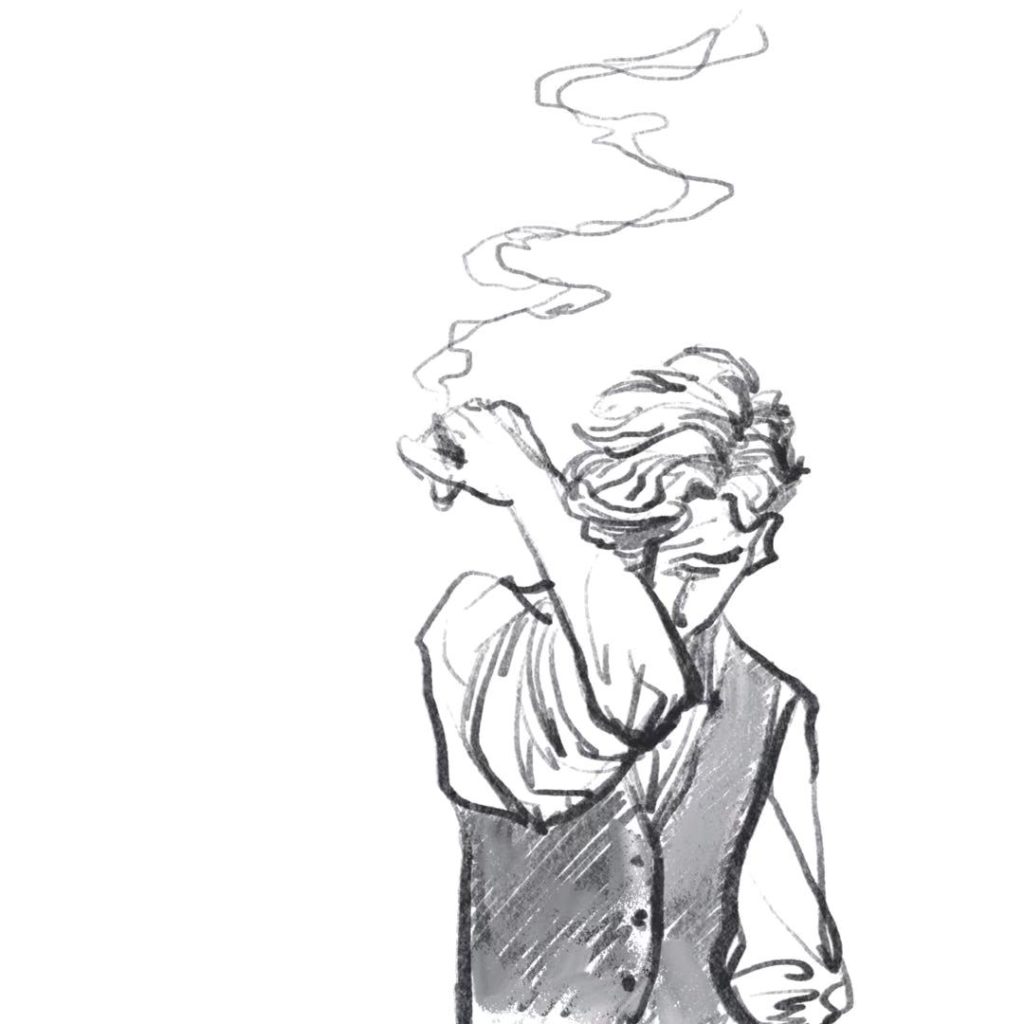
When the boy arrives home he meets his father standing on the porch . Here is an example of a ‘threshold’: a boundary between two ‘worlds.’ If the school represented a ‘safe’ place where he was sheltered and protected from hard truth, his house is the site of his revelation and the place where he will be exposed to the truth about how things are in the ‘real’ world. The porch is the dividing line between these two ‘worlds.’ His father (and Big Jim Evans ) function as symbolic gatekeepers. They know the truth, but do not reveal it to the boy, except through cryptic clues such as it had been a hard blow, language that suggests concealed emotion and also echoes the accident that killed his younger brother. Instead they usher him inside, where he will be passed from hand to hand, until he reaches his brother’s bedside . At this point, he will be by himself and have to face the reality of the world alone.
Just as in a good narrative, perspective is a crucial reason why the poem works so well. The speaker’s youth and naïvete brings a touch of irony into the poem. Each stanza gives more little clues, information hiding in plain sight, that the boy’s youth prevents him from fully understanding. But as readers looking in from outside, it’s relatively easy for us to piece together the puzzle at the heart of the story. The first puzzle-piece is probably the word knelling in stanza 1. It’s the kind of word a young boy wouldn’t know (the adult writer uses it as he looks back on his childhood experience). In stanza 2 – embedded inside two hyphens as an extra detail – is the admission that the speaker’s father had always taken funerals in his stride . In the third stanza old men stand up in formal way to shake my hand , and in the fourth we can infer from the whispers that informed strangers I was the eldest that something has happened to a member of the boy’s family. By the time the ambulance arrived with the corpse most readers will be prepared for the awful knowledge of the boy’s younger brother’s tragic accident.
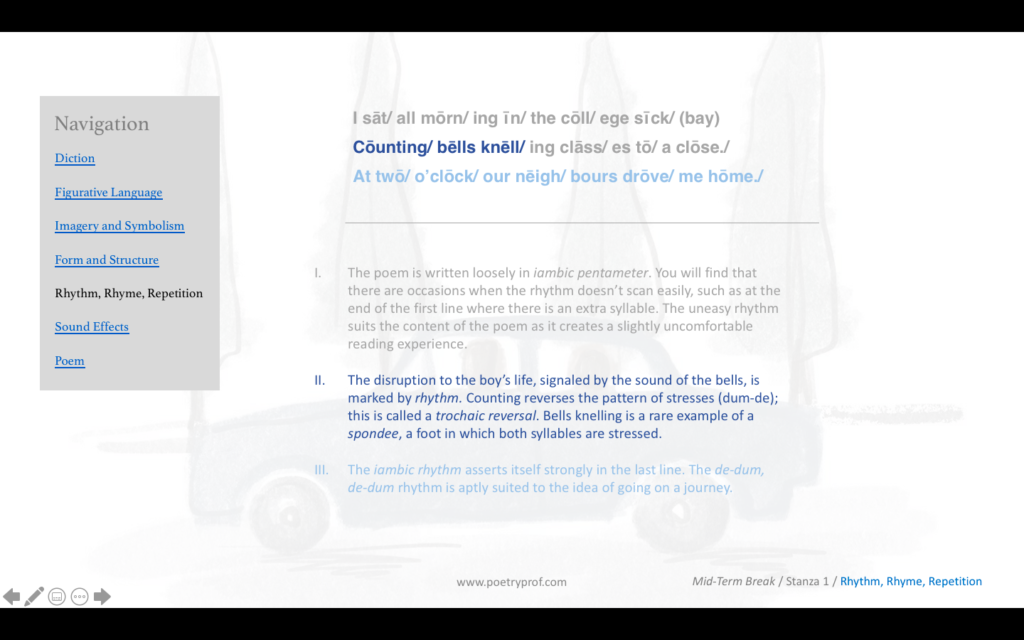
Written about a childhood time when nothing in the adult world makes sense (you can almost hear the boy thinking, ‘Why are they whispering? Why are these old men standing up to shake my hand?’) the voice of the speaker conveys Heaney’s thoughts and curiously detached feelings through this bewildering day. Interestingly, most of the diction in the poem is cool, calm and collected, and the young speaker comes across as matter-of-fact above anything else. Read the poem again to try and find examples of emotive language – it’s tough, right? That’s not to say the poem isn’t emotional, but emotion comes more from the reader’s grasping of the situation than from the poem itself. The boy himself reports everything with simplicity: stanched and bandaged is quite clinical; I saw him for the first time in six weeks a simple matter-of-fact statement. The clinical, detached tone aptly conveys the way a young boy might approach his first encounter with death. Too young to really grasp the significance of events, he reacts in a way that might even be construed as indifferent.
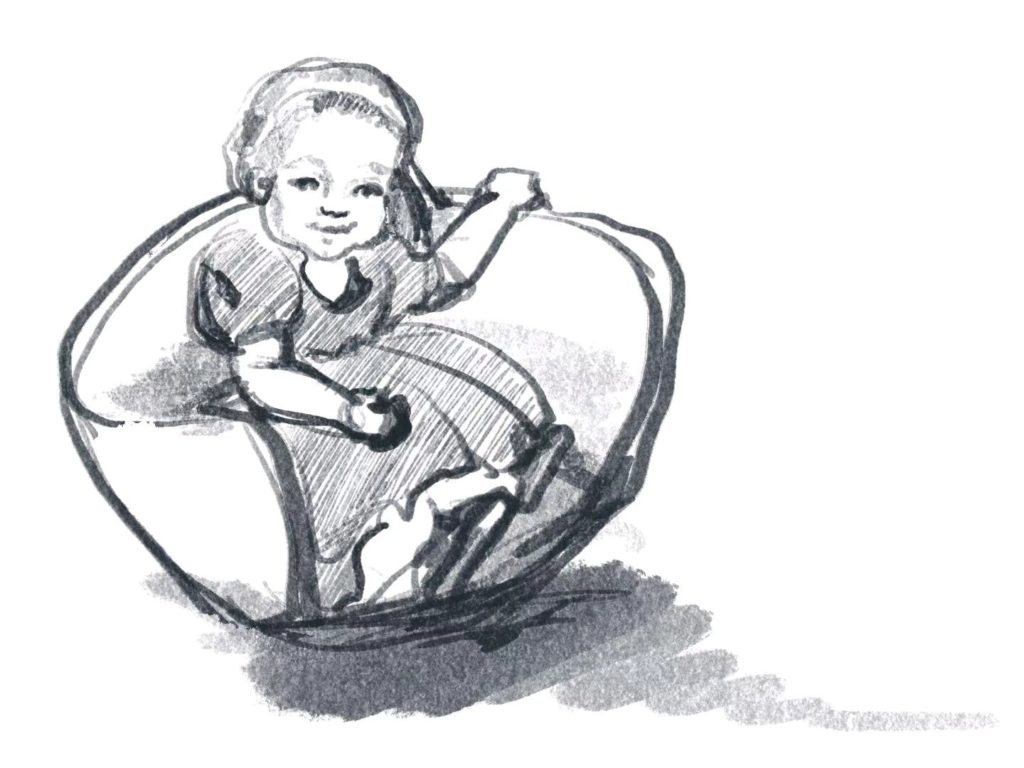
Something the poem explores wonderfully well is the stoic, masculine way that men deal with their emotions, particularly grief. The speaker’s father had been crying, but the poem is quick to point out that normally he takes things in their stride. Big Jim Evans is unable to use straightforward language when talking to the young boy and euphemises his feelings as a hard blow . Euphemism is language that is uses to disguise, or avoid, speaking hard truths and it’s again ironic that somebody big, when faced with a harsh reality, finds it difficult to confront. Old men stand up to shake my hand reveals how formality and custom are used (again by men) to manage difficult emotions. Whispers is an onomatopoeia that conjures the sound of people talking around him, even behind his back, but hesitant when it comes to admitting the truth. The mother, true to type, is permitted to cough out her angry tearless sighs . She has been exhausted by her outpouring of emotion: by contrast, the men keep theirs firmly shut away inside. A detail that throws the men’s stoicism into sharp relief is the mention of the baby who cooed and laughed in the pram. The contrast of such unknowing, innocent behaviour with the reserved and awkward behaviour of the adults only reinforces the formality of their actions.
According to the poetic tradition of the turn , or volta , at a certain point in a poem the focus shifts, the tone changes or a counterpoint is presented. Mid-Term Break’s turn is disguised by form, hidden inside the fifth stanza. After the description of mother’s sighs our attention is taken away from the reactions of those gathered in the house and placed onto the ambulance, there to deliver the body of the speaker’s younger brother. At ten o’clock is the subtle marker used to make this change. After this point, the poem homes in on the boy’s experience only and we are with him through the terrible walk up the stairs, into the room where his brother’s body is laid in state stanched (like the more common ‘staunch,’ this word means to restrict the flow of blood; you can read it to mean ‘cleaned’) and bandaged by nurses . Assonance plays a part in this stanza: the letter A flows through the lines in all kinds of words such as a ngry , a mbul a nce a rrived , st a nched a nd b a nd a ged . Assonance helps manage the tension in the poem at this crucial moment – the boy is only steps away from entering the room himself and coming face to face with his brother after his awful accident.

Once he enters the site of revelation, the poem intensifies its use of imagery. The evidence of his brother’s wound is described as a poppy bruise , the vivid red colour that flashes into our minds when we read poppy contrasts with the white images suggested by paler now , stanched and bandaged and snowdrops (white flowers) and candles soothed the bedside . Like the knelling bells , this use of language comes from the older writer looking back on his childish persona. Look again at the word ‘soothed.’ Flowers and candles are personified to have a calming effect on the scene, and we are invited to compare the ritual trappings of funerals with the formality of behaviour displayed by the men earlier in the poem. The votive candles have a particularly calming effect, bathing the scene in warmth despite the ‘cold’ setting and tone. Perhaps Heaney wants us to think that the objects in the room, the ritual ‘embalming’ of the corpse – like the words and behaviour of the people downstairs – are all bent to the same purpose: the dulling of grief in order to allow men to cope with, and display stoicism in the face of, this ‘unmanly’ emotion.
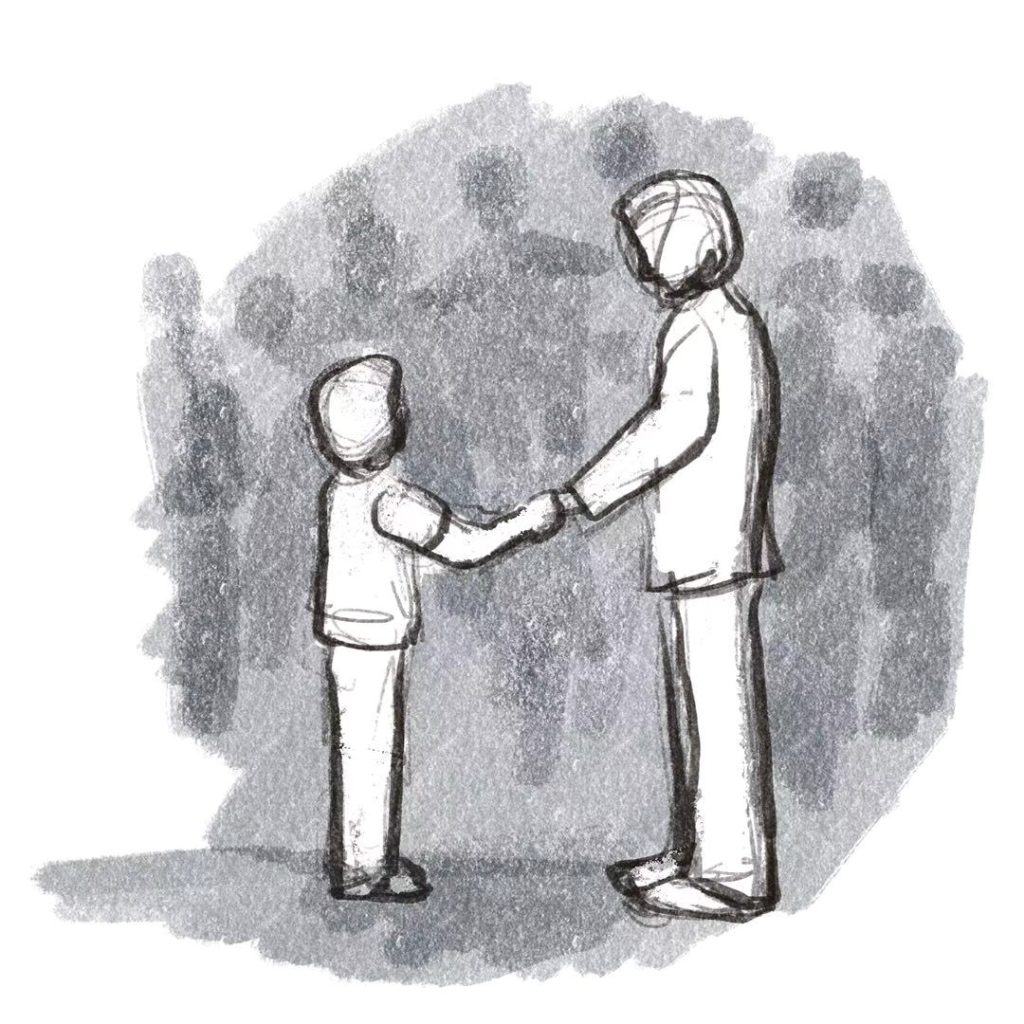
The importance of ritual is echoed in the poem’s form. Heaney is a traditional poet, and his poetry gestures towards pre-modern times . Mid-Term Break is written in unrhymed tercets (a tercet is a group of three lines) and Heaney employs stanzaic form to echo both the rituals surrounding death and funerals, and to frame the procession by which the boy is brought from his school to the bedside. Try breaking the journey into stages, imagining him passing various thresholds along the way: he leaves the college sick bay , passes through the porch into the main house, and goes up to the room . Each stanza narrows and focuses the boy’s journey until he reaches the bedside , at which point the poem is at its most intimate: just the boy, his brother and us watching from the outside. The repetition of hands is a nice detail helping us to see that he is quite literally passed from hand-to-hand by various adults. He is taken by his neighbour, to his father, through a roomful of relatives and strangers (who shake his hand ) to his mother (who held my hand ). Finally, he visits the bedside where he is alone. The structure of this journey is like a mini ‘rites of passage’ story, taking a child from a safe, protected world and exposing him to the truth and danger of the adult world.
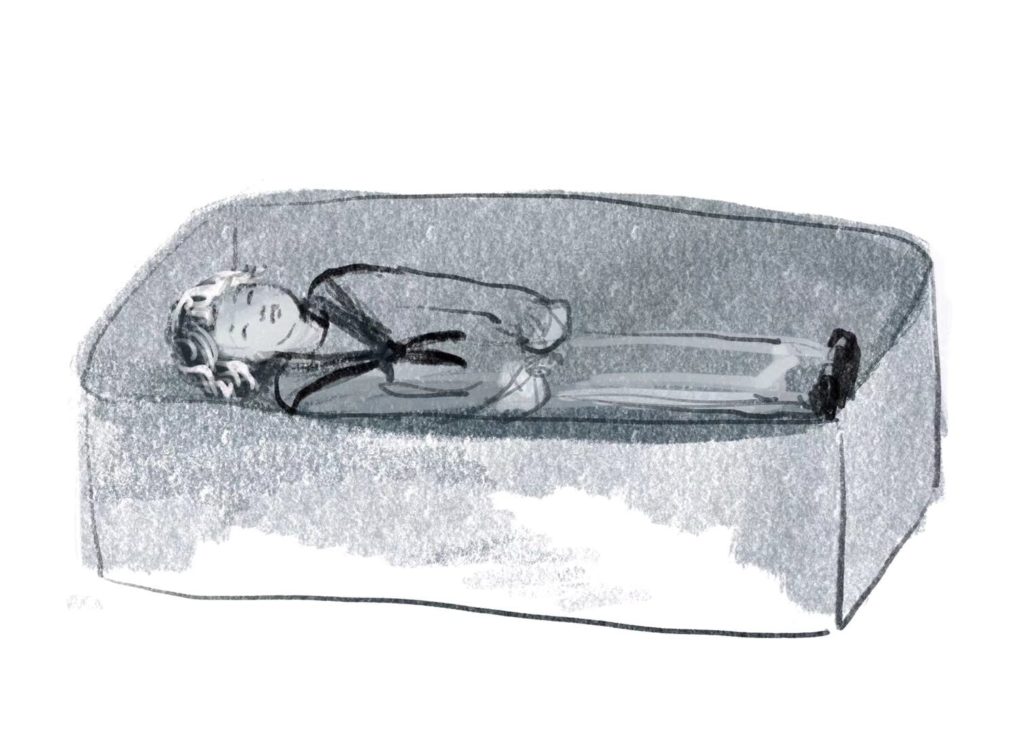
Suggested Poems for Comparison
- Death of a Naturalist by Seamus Heaney
If you liked Mid-Term Break , you’ll love Death of a Naturalist . The title poem from his 1966 collection (from which Mid-Term Break is taken), the poem’s speaker – Heaney as a child – witnesses an invasion of angry frogs who he describes as ‘the great slime kings.’
- Hide and Seek by Vernon Scannell
If you’ve ever played this childhood game, you might recognise what happens to the small boy in this poem – abandoned in the dark by those he thought were his friends. It’s a little taste of how things really work out in the real world, represented by the eerie way the empty garden seems to look back at him at the end of the poem.
- Little Red Cap by Carol Ann Duffy
It’s not only boys who go on rites of passage adventures. In this reworking of the classic fairytale ( Little Red Riding Hood ), Duffy imagines herself as the titular heroine, a person with whom it is not wise to mess!
Additional Resources
If you are teaching or studying Mid-Term Break at school or college, or if you simply enjoyed this analysis of the poem and would like to discover more, you might like to purchase our bespoke study bundle for this poem. It’s only £2 and includes:
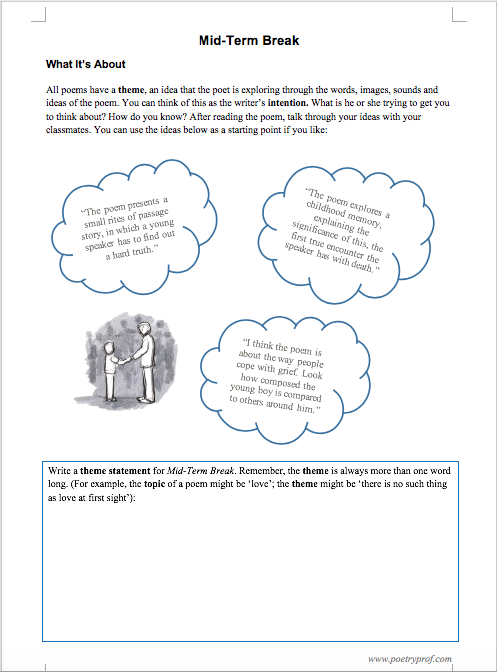
- 4 pages of activities that can be printed and folded into a booklet for use in class, at home, for self-study or revision.
- Study Questions with guidance for how to answer in full paragraphs.
- A sample Point, Evidence, Explanation paragraph for essay writing.
- An interactive and editable powerpoint, giving line-by-line analysis of all the poetic and technical features of the poem.
- An in-depth worksheet with a focus on explaining stanzaic form .
- A fun crossword-quiz, perfect for a recap lesson or for revision.
- 4 practice Essay Questions – and one complete model Essay Plan.
And… discuss!
What did you think of Seamus Heaney’s poem? Have you read any of his other works that you could recommend to people who enjoyed Mid-Term Break? How did you feel at the end of this poem – was the revelation a shock to you? Why not leave a comment, start a discussion or share your ideas in the comment section below. And, for daily nuggets of analysis and all-new illustrations, don’t forget to find and follow Poetry Prof on Instagram.
Leave a Reply Cancel reply
Your email address will not be published. Required fields are marked *
Notify me of follow-up comments by email.
Notify me of new posts by email.

A novelist, poet and lecturer at Akwa Ibom State University. He has a PhD in African literature from the University of Ibadan, Nigeria.
An Analysis of Seamus Heaney’s ‘Mid-term Break’
‘Miditerm Break’ is a deeply melancholic poem written by the Irish poet, Seamus Heaney, as a way of coping with the grief and pain associated with losing a loved one. Thus, ‘Midterm Break’ is a personal poem. A work of art is said to be personal when it is based on the personal experiences of its author. Heaney lost his younger brother Christopher during childhood in a road accident. ‘Mid-term Break’ is a narrative poem that recreates the sad moments following this loss based on the poet’s recollection or re/memory.
‘Mid-term Break’ is organised in eight stanzas. All the stanzas except the final one are rendered in tercets. The final stanza is just one line. A one-line stanza is called monostich. The poem is written in run-on-line or enjambment. It is also written in free verse. The first stanza goes thus: ‘I sat all morning in the college sick bay/Counting bells knelling classes to a close./At two o’clock our neighbours drove me home.’
In the poem, the persona recounts finding himself in the sick bay of his school. It is obvious that the narrator is the poet himself. He must have learnt of the sad news and fallen sick with grief, hence his being taken to the sick bay. It might also be a practical routine to relieve him of school work and set him apart from the rest of the students for care and attention. The second line of the first stanza contains alliteration with the repetition of the voiceless velar plosive in ‘counting’, ‘classes’ and ‘close’. The word ‘knelling’ has an onomatopoeic texture and constitutes a pun as well. The bells do not only announce the end of classes in the school, it, by metaphoric extension, also announces the end of a life; in this case, the life of young Christopher. The stanza ends with the neighbours coming to collect the persona. This is one of the instances of abnormality in the poem. It should have been the parents coming for the boy.
In the second stanza, the persona has got home and seen the father crying. The assertion that the father has always taken funeral at his strides is ironic when paired with the first expression which depicts the man in tears. This contrast serves to highlight how painful this particular loss is to the man, so that he cannot help but cry. No wonder another character in the poem by name Big Jim Evans refers to the loss as ‘a hard blow’, an expression that constitutes metaphor in the poem.
The third stanza reads: ‘The baby cooed and laughed and rocked the pram/When I came in, and I was embarrassed/By old men standing up to shake my hand’. The first line of this stanza is a loose sentence and the entire stanza is presented in paratactic style. The description of the baby’s innocence deepens the mood of tragedy in the poem. The word ‘cooed’ is onomatopoeic as it describes the sound made by a baby. Together with ‘laugh’, it constitutes auditory imagery which is very rich in the poem, as can be seen in words like ‘crying’ and ‘knelling’ in the first stanza. The word ‘rocked’ is a movement word and constitutes kinesthetic imagery, as well as ‘standing’ and ‘shake’. The act of old men standing up to greet the young persona is used to suggest the abnormality of the situation at hand. It is not an every-other-day situation. It is not normal for old people to courtesy a young person; neither is it normal for a boy to die while old people mourn him. It should be the other way round.
The fourth stanza of the poem continues from the third and recounts how the elderly mourners attempt to console the poor young persona. The occasion also provides an avenue for the family information or history/gossip to be passed round by the mourners: ‘Whispers informed strangers I was the eldest/Away at school’. This is an example of personification as ‘Whispers’ is imbued with a human attribute. The mother holding the persona’s hand denotes an attempt at either consoling him or comforting herself that she still has a child left in the world, or both.
The fifth stanza is equally a continuation from the fourth stanza. It presents a paradoxical situation as it indicates that the mother’s reaction to the loss is that of anger, tearlessness and sighs compared to the outright crying earlier reported about the father. The words ‘coughed’ and ‘sighs’ exemplify auditory imagery in the poem. The stanza uses visual imagery in reporting the arrival of the ambulance, which is a symbol of death and tragedy in the poem. The presence of words like ‘ambulance’, ‘corpse’, ‘stanched’, ‘bandaged’ and ‘nurses’ constitutes visual imagery which are drawn from medical or hospital register. The arrival of the corpse authenticates the story that the poem narrates. It is like the presentation of evidence to prove one’s account of an event. The word ‘stanched’, in the poem’s context, denotes the use of cotton to stop the flow of blood or the insertion of cotton in the nostrils of a corpse.
In the sixth stanza, the persona recounts going upstairs to the room where the remains of the younger brother are laid. The expression ‘Snowdrops/And candles soothed the bedside’ is an example of personification. ‘Snowdrops’ is a type of flower; in this case, it is a symbol of grief and mourning, as well as a celebration of the dead. It is used to pay tribute to the departed. The same interpretation goes for the candles. The persona states: ‘I saw him/For the first time in six weeks. Paler now’. The third person pronoun ‘him’ as used in the expression refers to the deceased. By this statement, it is clear that the brother has been away at school for six weeks during which time he was apart from his brother. Conventionally, midterm break takes place within the sixth and the seventh week of the term. It would appear that his has come a week too soon. It could also be that that the persona is going to use his midterm break to mourn his brother. The title of the poem could also refer to the temporality that signals the demise of the poet’s beloved brother. The idea of midterm break might suggest an abrupt interruption of the persona’s studies to mourn his deceased brother. The expression ‘Paler now’ is a sad euphemism because it describes the deceased’s complexion. Pale is the complexion of death and the dead.
The penultimate stanza is a continuation from the sixth stanza. It continues the description of the corpse. The expression ‘poppy bruise’ is another euphemism which describes the wound incurred by the late brother when the accident occurred. The word ‘poppy’ is an adjective and constitutes a visual imagery in the poem. The expression in the second line, ‘He lay in the four-foot box as in his cot’, is another tragic euphemism, as the phrase ‘four-foot box’ refers to a child’s coffin, which is compared to a cot, a child’s sleeping space. Thus, death is compared to the act of sleeping in this poem. The simile should not be lost on any reader of the poem. The last line of the stanza also uses euphemism to represent the brutal way the brother died: ‘No gaudy scars, the bumper knocked him clear’. ‘The bumper’ is an instance of synecdoche as it represents the car that hit the deceased. The final monostich presents the numeric significance of the deceased’s coffin: ‘A four-foot box, a foot for every year’. Christopher was only four years old when he died. ‘Mid-term Break’ can thus be read as an elegy or a threnody.
Seamus Heaney won the Nobel Prize for literature in 1995. He was born in 1939, the year World War II started. He died in 2013.
How does Seamus Heaney represent death and grief in ‘Mid-term Break’?
Related Posts
An analysis/summary of susanne bellefeuille’s path of lucas: the journey he endured, an analysis of wole soyinka’s ‘night’, 4 thoughts on “ an analysis of seamus heaney’s ‘mid-term break’ ”.
I didn’t know that.
excellent points altogether, you just gained a new reader. What would you recommend about your post that you made some days ago? Any positive?
I really love the way you discuss this kind of topic..”…
I am glad to be a visitant of this thoroughgoing site ! , thanks for this rare information! .
Leave a Reply Cancel reply
Your email address will not be published. Required fields are marked *
Save my name, email, and website in this browser for the next time I comment.

IMAGES
VIDEO
COMMENTS
By. 'Mid-Term Break' by Seamus Heaney describes the emotional turmoil experienced by a speaker who has lost a loved one in a traumatic way. Seamus Heaney is one of the best-loved poets of all time. After he passed away in 2013, the world went into grieving. 'Mid-Term Break' was published in Death of a Naturalist, Heaney's most-famous ...
Get LitCharts A +. "Mid-Term Break" was published by Irish poet Seamus Heaney in his 1966 book Death of a Naturalist. The poem is about Heaney's brother, who was killed by a car in 1953 when he was only 4 years old, and Heaney only 14. Personal and direct, the poem describes the unexpected ways his family's grieves as they confront this ...
Poetry Essay: Mid-Term Break by Seamus Heaney. Heaney used both the title and imagery to covey the message of the poem. The message of this poem is that death changes things: how people act towards those mourning, how people in mourning will experience everyday situations differently, and how life changes because of loss.
7626. 'Mid-term Break' was written in 1966 by Seamus Heaney. This poem is autobiographical as it was written about a real event of Heaney's life. It is about him and his family grieving from the death of his four year old brother. When the tragedy struck he was only fourteen. This poem focuses on how people reacted to the death.
In the poem 'Mid-Term Break' belonging to the collection 'Death of a Naturalist' (1966), the poet Seamus Heaney thoroughly explores the theme of children sometimes being forced to grow up. The memory poem presents the tragedy which forced Seamus Heaney to come of age, laying out in snapshot-like form the instances that marked the ...
Get Custom Essay. Seamus Heaney's poem "Mid-Term Break" is a powerful meditation on the experience of loss and grief. Through vivid imagery and poignant language, the poem captures the profound emotional impact of the death of a loved one, and the ways in which such a loss can shape our perceptions of the world around us. In this essay, I will ...
At ten o'clock the ambulance arrived. With the corpse, stanched and bandaged by the nurses. Next morning I went up into the room. Snowdrops. And candles soothed the bedside; I saw him. For the first time in six weeks. Paler now, Wearing a poppy bruise on his left temple, He lay in the four-foot box as in his cot.
Snowdrops. And candles soothed the bedside; I saw him. For the first time in six weeks. Paler now, Wearing a poppy bruise on his left temple, He lay in the four-foot box as in his cot. No gaudy scars, the bumper knocked him clear. A four-foot box, a foot for every year. Seamus Heaney, "Mid-Term Break" from Opened Ground: Selected poems 1966-1996.
The early poem 'Mid-Term Break' was written by Seamus Heaney following the death of his young brother, killed when a car hit him in 1953. It is a poem that grows in stature, finally ending in an unforgettable single-line image. "My poems almost always start in some kind of memory . .." Seamus Heaney said, and this poem is no exception.
October 4, 2020. 'Miditerm Break' is a deeply melancholic poem written by the Irish poet, Seamus Heaney, as a way of coping with the grief and pain associated with losing a loved one. Thus, 'Midterm Break' is a personal poem. A work of art is said to be personal when it is based on the personal experiences of its author.
Mid-Term Break Study Guide. " Mid-Term Break " is a poem by Seamus Heaney, first published in his debut collection Death of a Naturalist in 1966. The poem reflects on experiences from Heaney's own life. In 1953, when the poet was just fourteen years old, his little brother Christopher—ten years younger—was tragically killed in a car ...
This tragic tale is the true story of Seamus Heaney's brother Christopher. The young boy was struck and killed by a car when he was only four years old. Seamus Heaney, after learning about the tragedy, came back from boarding school to be with his family. A year later, he composed the poem " Mid-Term Break " to deal with his feelings ...
Mid-Term Break. I sat all morning in the college sick bay. Counting bells knelling classes to a close. At two o'clock our neighbors drove me home. In the porch I met my father crying—. He had always taken funerals in his stride—. And Big Jim Evans saying it was a hard blow. The baby cooed and laughed and rocked the pram.
The title 'Mid term break' gives us the disillusion that the poem is going to be an upbeat poem; we associate it about a holiday away from the stresses of school. The opening stanza upsets out expectations as it has a melancholy tone and the usage of rather pessimistic words such as 'close' and 'sick'.
The death of a very young child in this poem is so shocking that it alters and subverts every surrounding family relationship. The laughter of the baby appears not life-affirming or joyful, but haunting and almost offensive. The oldest child, our speaker, becomes a kind of parent to his own parents, holding his mother's hand and greeting guests ...
Discussion/Analysis of the poem "Mid-term Break" by Seamus Heaney. Annotations with voice-over teaching.Mid-Term BreakBY SEAMUS HEANEYI sat all morning in th...
Poetry Essay December 6, 2001 . The Death of a Little Boy Seamus Heaney's "Mid-Term Break" tells of a tragic car accident that took the life of a little boy. His brother, who narrates the poem, is away at college and sees his little brother for the first time in six weeks but also for the very last time.
Created by: D. Troskie. STEP 1. READ YOUR QUESTION. • Make sure that you know what you are asked to write. about. • Highlight your instructions to insure that you stay on topic. QUESTION 1: In a perfectly planned essay, critically discuss how. the poet uses the title and imagery to convey the.
Mid-Term Break Essay. The poem 'Mid-Term Break' by Seamus Heaney is a first person ballad concerning the death of a boy's 4-year-old brother while he was away at boarding school, and the individual reactions of each of his family members towards the tragedy. Poet Seamus Heaney did well at taking the extremely heavy subject of a child's ...
Mid-Term Break Essay Questions. 1. Discuss the significance of the "college sick bay." The speaker's sojourn in his school's infirmary, as he waits to be picked up for his brother's wake, foreshadows the poem's upcoming events. The setting hints at death, illness, and dying. At the same time, it offers a glimpse at a medicalized, institutional ...
Mid-Term Break Questions and Answers - Discover the eNotes.com community of teachers, mentors and students just like you that can answer any question you might have on Mid-Term Break
CIE IGCSE Poetry Anthology. Book. Songs of Ourselves. Here's a full analysis of the poem 'Mid-Term Break' by Seamus Heaney, tailored towards GCSE/IGCSE students but also suitable for those studying Heaney at a higher level. Includes: VOCABULARY STORY / SUMMARY SPEAKER / VOICE ATTITUDES LANGUAGE FEATURES STRUCTURE / FORM CONTEXT THEM...
The poem "Mid-Term Break" by Seamus Heaney describes the death of his infant brother. In the first stanza, Heaney sits in the college sick bay all morning after being called home, listening to funeral bells. When he arrives home, he finds his father crying, which is unusual as his father had always "taken funerals in his stride." The next day, Heaney sees his brother's body for the first time ...